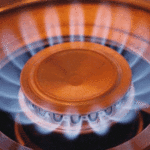Natural gas pared its weekly advance on Thursday after the Energy Information Administration reported a larger-than-expected build in US natural gas inventories in the week ended October 31st. However, the energy source remained on track to post a sizable weekly gain amid strong heating demand expectations in the Midwest and Northeast.
On the New York Mercantile Exchange, natural gas for delivery in December fell 1.14% to $4.146 per million British thermal units by 15:34 GMT. Prices ranged between $4.245, close to Wednesday’s 4-month high of $4.315, and $4.119. The contract edged up 1.57% on Wednesday to $4.194 per mBtu, and is up around 7% so far this week.
The Energy Information Administration reported that US natural gas stockpiles rose by 91 billion cubic feet in the week through October 31st, exceeding analysts projections for a jump of 85-87 bcf. This was the 29th straight above-average weekly build, sharply exceeding the five-year average gain of 42 billion cubic feet and last years gain of 35 bcf during the comparable week.
Total gas held in US storage stood at 3.571 trillion cubic feet, narrowing its deficit to the five-year average of 3.832 trillion by 1.4% to 6.8% from a week earlier. Gas stockpiles were 6.2% below year-ago levels.
The East region received a net injection of 43 bcf to 1.956 trillion and stood 5.2% below average levels, while inventories in the West region rose by 8 bcf to 498 bcf, narrowing their deficit to the average of 528 bcf to 5.7%. Stockpiles in the Producing region gained 40 billion cubic feet to 1.117 trillion and were 10% below the average.
Arctic air supports
Despite the bearish supply data, however, the energy source remained on track to post a sizable weekly gain, possibly one of the biggest this year, amid expectations for high heating demand in the Midwest and Northeast due to arctic air flows from Canada.
According to NatGasWeather.com, natural gas demand in the US over the next seven days will become high, compared to normal, with a slightly colder weather trend for the November 13-19 time span.
Over the next couple of days the first of many weather systems will push out of the Midwest and flow into the eastern U.S., as rain showers will indicate its arrival, followed by snowfall. Light accumulations of snow are expected on Friday over portions of the Great Lakes and New England.
High pressure will continue to provide normal temperatures and dry conditions over the western U.S., with the exception of the Northwest, where a Pacific weather system will bring showers.
A second wave of moisture starved weather systems is expected to hit the Midwest and interior Northeast this weekend, NatGasWeather.com said in a report, before an arctic blast moves into the north-central U.S. late this week, bringing temperatures well below normal.
During the weekend and early next week Canadian arctic air will infiltrate the Midwest and Northeast, pushing temperatures under the normal. It will be chilly in the southern US, but as the week progresses, weather conditions will warm up to near normal. Meanwhile, the western US will remain warm and dry as high pressure dominates.





